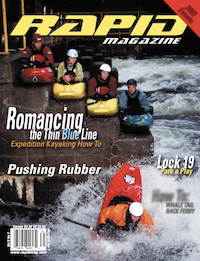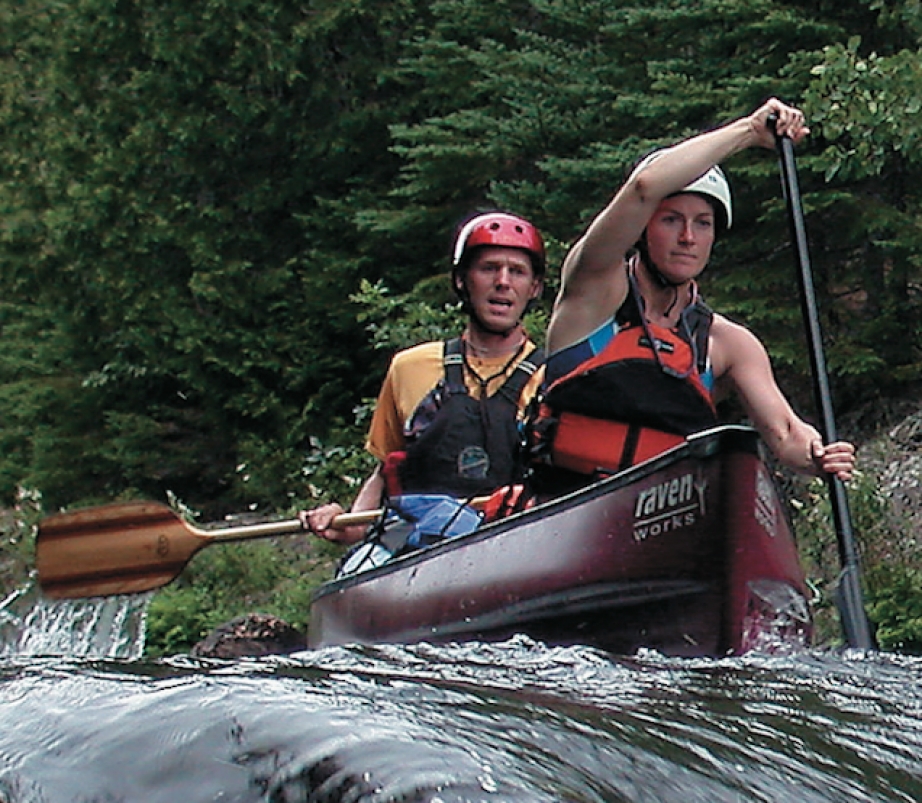With Dagger scaling back their whitewater canoe division, there’s a gap in the market for smaller start-up companies like Raven Works, which began building boats in 2000 and makes the 17’ Nemesis (16’11”) tandem whitewater tripping boat.
Design
Most whitewater tripping boats are a compromise between efficiency on the flats and manoeuvrabity and dryness in the rapids. Lakewater tripping canoes have sharp lines that offer efficiency but the resulting low volume usually leaves whitewater paddlers crashing through waves rather than riding over them. Whitewater boats sacrifice speed with blunt, voluminous ends for buoyancy. Nemesis designer Skip Izon set out to combine the best of both.
The bottom section of the Nemesis’ bow and stern has the sharp lines of a touring canoe. Above that the hull flares radically. The idea is to give the boat a waterline profile that’s sharp for speed in lakewater, while the flare sheds water from the bow and stern. Izon also gave the Nemesis an asymmetrical hull, which adds straight-ahead speed but means it’s not intended to be spun around and paddled solo from the bow seat.
The hull
We took a prototype of the Nemesis on a four-day trip down the Petawawa River and found that not only was it great on the lake sections, but the rocker—four inches at the bow and two inches at the stern—was enough to let it snap in and out of eddies. With plenty of tumblehome at the paddling positions, the boat felt narrow and it was easy to plant quality strokes.
But we weren’t convinced that our Nemesis- in-progress fit its billing as a big water tripping boat. Other paddlers could see the water shedding off the bow flare as designed to but there just wasn’t enough boat above the water to keep us dry.
A quick phone call after our trip saw us set up with a much deeper and drier production model. Izon had added almost five inches to the depth for a full 21 inches in the bow, 15.5 in the centre and 20 in the stern, ensuring a dry ride.
The interior
One result of the Nemesis’ chisel-sharp entry lines is the notable lack of interior volume in the bottom of the bow and stern. If you’re packing flotation this isn’t an issue, but if you need the space for gear, your drybags better be long and narrow. Bow paddlers used to ample legroom have to get used to the tapered bow.
The webbing seats are bolted to aluminum hanger brackets rather than ash spindles, a durable system unlikely to break or rot. The aluminum flexes, allowing the seat to shift side-to- side. The seats are set quite low and can easily be raised for tall and big-footed paddlers by inserting wood spacers between the seat and the bracket. There is plenty of room mid-ship for tripping gear although you’ll have to re-drill the vinyl-covered aluminum gunwales and move the thwarts to accommodate four blue barrels, if that’s your system.
No compromise
Unless you’re fortunate enough to paddle exclusively continuous mountain rivers, choosing a whitewater expedition boat has always meant choosing between flatwater efficiency and whitewater performance. What sets the Nemesis apart is its hull shape designed to eliminate the compromise.
Specs
- Length: 16’11”
- Width: max 38”, waterline 33.75”
- Depth: bow 21”, centre 15.5”, stern 20”
- Rocker: bow 4”, stern 2.5”
- Shape: asymmetrical, buoyancy 53% aft
- Recommended capacity: designed 400-700 lbs, max 1,200 lbs
- Weight: 75 lbs in Royalex
- MSRP: $1,095 USD / $1,725 CAD









